牛津小学英语1A Unit1教案
牛津苏教版-英语-一年级上册-1A Unit1 Hello全课时教案
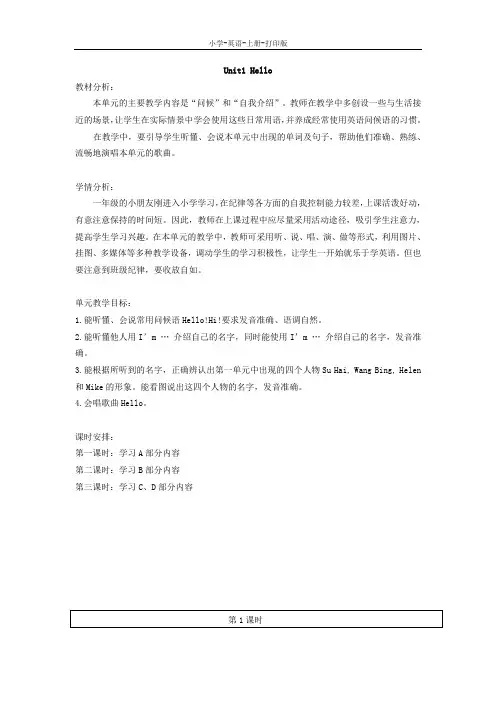
Unit1 Hello
教材分析:
本单元的主要教学内容是“问候”和“自我介绍”。
教师在教学中多创设一些与生活接近的场景,让学生在实际情景中学会使用这些日常用语,并养成经常使用英语问候语的习惯。
在教学中,要引导学生听懂、会说本单元中出现的单词及句子,帮助他们准确、熟练、流畅地演唱本单元的歌曲。
学情分析:
一年级的小朋友刚进入小学学习,在纪律等各方面的自我控制能力较差,上课活泼好动,有意注意保持的时间短。
因此,教师在上课过程中应尽量采用活动途径,吸引学生注意力,提高学生学习兴趣。
在本单元的教学中,教师可采用听、说、唱、演、做等形式,利用图片、挂图、多媒体等多种教学设备,调动学生的学习积极性,让学生一开始就乐于学英语。
但也要注意到班级纪律,要收放自如。
单元教学目标:
1.能听懂、会说常用问候语Hello!Hi!要求发音准确、语调自然。
2.能听懂他人用I’m…介绍自己的名字,同时能使用I’m …介绍自己的名字,发音准确。
3.能根据所听到的名字,正确辨认出第一单元中出现的四个人物Su Hai, Wang Bing, Helen 和Mike的形象。
能看图说出这四个人物的名字,发音准确。
4.会唱歌曲Hello。
课时安排:
第一课时:学习A部分内容
第二课时:学习B部分内容
第三课时:学习C、D部分内容。
最新《牛津小学英语1A》全册教案
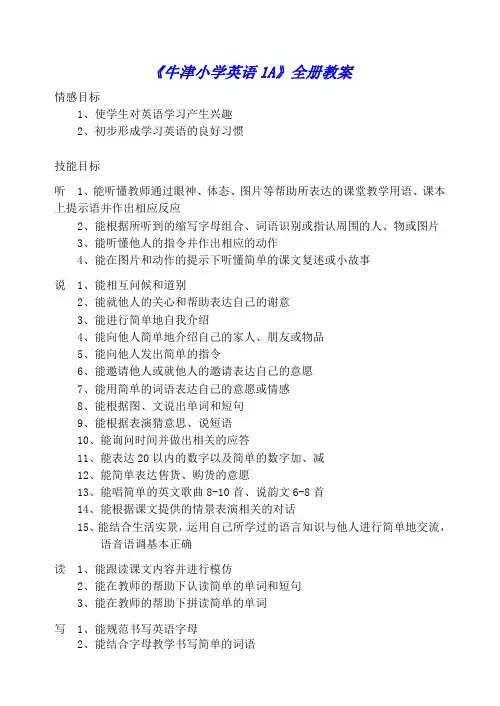
《牛津小学英语1A》全册教案情感目标1、使学生对英语学习产生兴趣2、初步形成学习英语的良好习惯技能目标听 1、能听懂教师通过眼神、体态、图片等帮助所表达的课堂教学用语、课本上提示语并作出相应反应2、能根据所听到的缩写字母组合、词语识别或指认周围的人、物或图片3、能听懂他人的指令并作出相应的动作4、能在图片和动作的提示下听懂简单的课文复述或小故事说 1、能相互问候和道别2、能就他人的关心和帮助表达自己的谢意3、能进行简单地自我介绍4、能向他人简单地介绍自己的家人、朋友或物品5、能向他人发出简单的指令6、能邀请他人或就他人的邀请表达自己的意愿7、能用简单的词语表达自己的意愿或情感8、能根据图、文说出单词和短句9、能根据表演猜意思、说短语10、能询问时间并做出相关的应答11、能表达20以内的数字以及简单的数字加、减12、能简单表达售货、购货的意愿13、能唱简单的英文歌曲8-10首、说韵文6-8首14、能根据课文提供的情景表演相关的对话15、能结合生活实景,运用自己所学过的语言知识与他人进行简单地交流,语音语调基本正确读 1、能跟读课文内容并进行模仿2、能在教师的帮助下认读简单的单词和短句3、能在教师的帮助下拼读简单的单词写 1、能规范书写英语字母2、能结合字母教学书写简单的词语第一单元教材分析一、单元教材分析本单元的主要教学内容是“问候”和“自我介绍”。
在教学中教师要多创设一些与学生生活接近的场景,让学生在实际情景中学会这些日常用语,并养成经常使用英语问候语的习惯。
教学过程中,要积极引导学生听懂、会说本单元中出现的单词和句子,帮助他们准确、熟练、流畅地演唱本单元的歌曲。
二、教学目标1、能听懂、会说日常问候语Hello!Hi!要求发音准确、语调自然。
2、能听懂他人使用I`m…介绍自己的名字,同时能使用I`m…介绍自己的名字,发音准确。
3、能根据所听到的名字,正确辨认出第一单元中出现的四个人物Su Hai,Wang Bing, Helen, Mike的形象,能看图说出这四个人物的名字,发音准确。
2024年牛津译林版1AUnit1Hello教案有教学反思
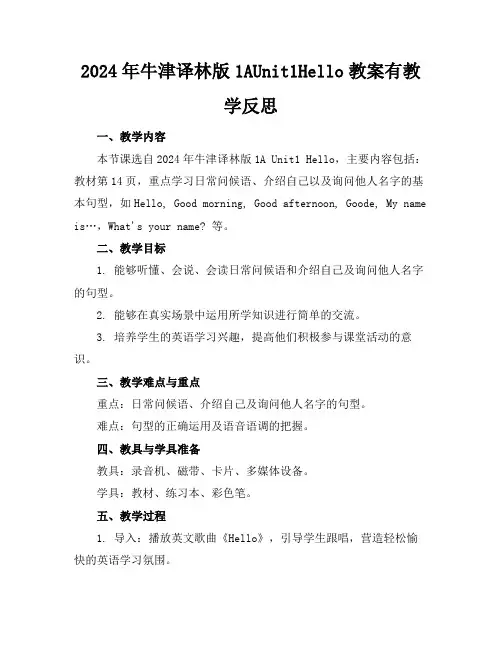
2024年牛津译林版1AUnit1Hello教案有教学反思一、教学内容本节课选自2024年牛津译林版1A Unit1 Hello,主要内容包括:教材第14页,重点学习日常问候语、介绍自己以及询问他人名字的基本句型,如Hello, Good morning, Good afternoon, Goode, My name is…,What's your name? 等。
二、教学目标1. 能够听懂、会说、会读日常问候语和介绍自己及询问他人名字的句型。
2. 能够在真实场景中运用所学知识进行简单的交流。
3. 培养学生的英语学习兴趣,提高他们积极参与课堂活动的意识。
三、教学难点与重点重点:日常问候语、介绍自己及询问他人名字的句型。
难点:句型的正确运用及语音语调的把握。
四、教具与学具准备教具:录音机、磁带、卡片、多媒体设备。
学具:教材、练习本、彩色笔。
五、教学过程1. 导入:播放英文歌曲《Hello》,引导学生跟唱,营造轻松愉快的英语学习氛围。
2. 新课内容展示:展示教材第14页,引导学生学习日常问候语、介绍自己及询问他人名字的句型。
3. 互动环节:学生分组进行角色扮演,模拟真实场景进行问候语交流,教师巡回指导。
4. 例题讲解:讲解教材第4页的例题,引导学生学会运用所学句型进行交流。
5. 随堂练习:学生完成教材第4页的练习题,巩固所学知识。
六、板书设计1. Unit1 Hello2. 内容:日常问候语:Hello, Good morning, Good afternoon, Goode介绍自己:My name is…询问他人名字:What's your name?七、作业设计1. 作业题目:用所学句型编写一段对话,要求至少包含日常问候语、介绍自己及询问他人名字。
根据教材第4页的图片,编写句子。
答案:1. 对话示例:A: Hello, Good morning!B: Hello, Good morning! My name is Tom.A: What's your name?B: My name is Jerry.A: Nice to meet you!B: Nice to meet you too!2. 图片句子示例:The boy's name is Jack.The girl's name is Lily.八、课后反思及拓展延伸本节课通过歌曲导入、真实场景模拟、例题讲解等多种教学方法,使学生掌握了日常问候语、介绍自己及询问他人名字的句型。
牛津英语1A第一单元教案(小学)上海版
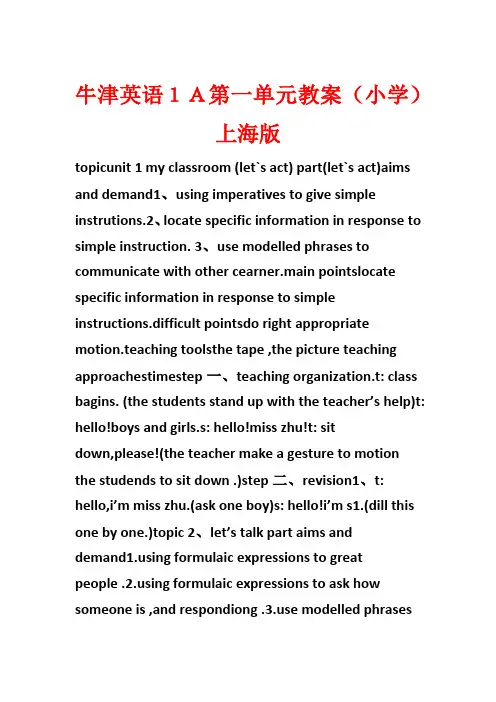
牛津英语1A第一单元教案(小学)上海版topicunit 1 my classroom (let`s act) part(let`s act)aims and demand1、using imperatives to give simple instrutions.2、locate specific information in response to simple instruction. 3、use modelled phrases to communicate with other cearner.main pointslocate specific information in response to simple instructions.difficult pointsdo right appropriate motion.teaching toolsthe tape ,the picture teaching approachestimestep一、teaching organization.t: class bagins. (the students stand up with the teacher’s help)t: hello!boys and girls.s: hello!miss zhu!t: sitdown,please!(the teacher make a gesture to motionthe studends to sit down .)step二、revision1、t: hello,i’m miss zhu.(ask one boy)s: hello!i’m s1.(dill this one by one.)topic 2、let’s talk part aims anding formulaic expressions to greatpeople ing formulaic expressions to ask how someone is ,and respondiong e modelled phrasesto communicate with the teacher and otherlearns.main pointslear the sentence “how are you !” “fine,thank you.”difficult pointshow to say “how are you !fine ,thank you.”teaching toolsthe tape teaching approachestimestep 一、teacher organization. t: class bagins. good mornimg ,boys and girls. s: good moring.miss zhu . (with the teacher’s help) ask one studend to sing an engish song ,step二、revision.1、let’s act .stand up, please! sit down,please!open your book ! close your book!ask some students to act them,one by one .step三、presention.1、listen to the song “hello,how are you!”listen to it carefully twice ,and to say “how are you !” “fine,thank you.” 2、lear to say . 课题〔教学内容〕let’s learn 课时1 教学目标〔情感、知识、技能〕1.understand and read the rhyme.2.sing the song .3.mastery the new word “pen rubber”重点mastery the parts of “let’s talk,let’s learn.” 难点using formulaic expressions to great people. 教具准备the tape .教学过程时间备注step一、teacher organization. t: class begins. good mornimg ,boys and girls. s: good morning.miss zhu . (with the teacher’s he lp) ask one student to sing anenglish song ,step二、revision .1、take out three pictures.it has notes:how are you ,fine ,thankyou .good morning .①read them together ②drill it with your partner. ③then some ss and drill them.2、words.take out some pictures and askstudents.topicunit 1 my classroom 4partaims and demands1、using modal verb “can” to express abilities.2、using nouns to identify common classroom objects.main pointslearn classroom objects .difficult points using modal verb “can”to expressabilities.teaching toolsthe tape . teaching approachestimestep 一、teacher organization. t: class begins. good mornimg ,boys and girls. s: good morning.miss zhu . (with the teacher’s help) ask one student to sing an english song .step二、revision .(一)、let’s act .1、play th e tape for “stand up ,please!”ask some students to act it and the rest of the class to judge right or wrong .2、give commands “boys ,stand up ,please.”“girls ,stand up ,please!’“the wholeclass ,stand up .” “boys ,open your books .”topicunit 2 number 1part let’s actaims and demand1、using imperatives to give simple instructions.2、using nounsto identify common classroom objects.3、using formulaic expressions to introduce oneself.4、using formulaic expressions to introduce your friends.main ing formulaic expressions to introduce your friends.difficult pointsthe sentence “this is .”teaching toolsthe tape . teaching approachesstep 一、teacher organization. t: class begins. good mornimg ,boys and girls. s: good morning.miss zhu . (with the teacher’s help) ask one student to sing an english song .step二、revision .(一)、sing the song “goodmorning”together.(二)、classroom objects.1、read them together.(twice)2、read them one by one .(三)、talking .t: good morning. t: how are you.s: good morning . s: fine ,thank you.t: i’m miss zhu .s1: i’m s1. topic unit 2 number 2 partaims and e formulaic expressions to greet people ing formulaic expressions to introduce ing formulaic expressions to introduce your friends.main pointsusing formulaic expressions to introduce your friends. difficult points introduce oneself and your friends.teaching toolsthe tape. teaching approachestimestep 一、teacher organization. t: classbegins. good mornimg ,boys and girls. s: good morning.miss zhu . (with the teacher’s help) a sk one student to sing an english song .step 二、revision.1. revision the classroom object vocabulary .ask the students what do you have in your bag?invite individuals to answer the question with the words they have learnt.2. t: (ask one student to stand up)say “give me a rubber ,please”and the student give me a rubber\etc please.let pair of students substitute “rule”and “rubber”with some other words they have learnt and act the dialogue .。
牛津英语1A Unit 1 my Classroom(第1课时)
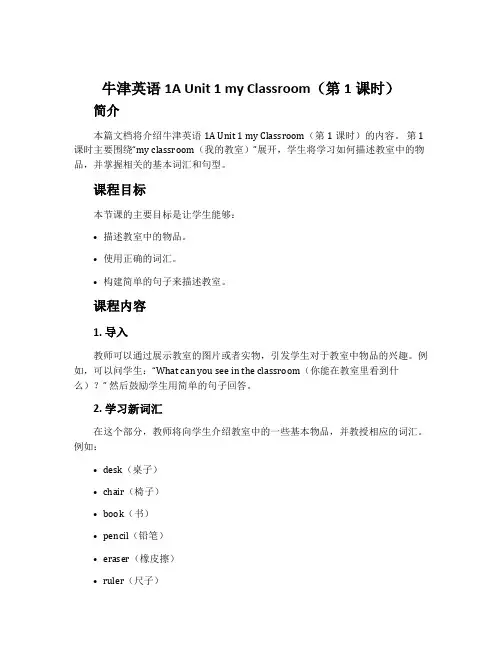
牛津英语1A Unit 1 my Classroom(第1课时)简介本篇文档将介绍牛津英语1A Unit 1 my Classroom(第1课时)的内容。
第1课时主要围绕“my classroom(我的教室)”展开,学生将学习如何描述教室中的物品,并掌握相关的基本词汇和句型。
课程目标本节课的主要目标是让学生能够:•描述教室中的物品。
•使用正确的词汇。
•构建简单的句子来描述教室。
课程内容1. 导入教师可以通过展示教室的图片或者实物,引发学生对于教室中物品的兴趣。
例如,可以问学生:“What can you see in the classroom(你能在教室里看到什么)?” 然后鼓励学生用简单的句子回答。
2. 学习新词汇在这个部分,教师将向学生介绍教室中的一些基本物品,并教授相应的词汇。
例如:•desk(桌子)•chair(椅子)•book(书)•pencil(铅笔)•eraser(橡皮擦)•ruler(尺子)教师可以通过展示图片或实物的方式来帮助学生记忆这些新词汇。
同时,教师可以播放一些与这些物品相关的游戏或者歌曲来帮助学生更好地学习。
3. 句子表达在这个部分,教师将教授学生如何用所学的词汇构建简单的句子来描述教室。
例如,教师可以教授以下句型:•There is a desk in my classroom.(我的教室里有一张桌子。
)•There are two chairs in my classroom.(我的教室里有两把椅子。
)•I have a book.(我有一本书。
)教师可以通过举例子和示范的方式,让学生理解并掌握这些句型。
4. 练习活动在这个部分,教师可以设计一些练习活动来帮助学生巩固所学内容。
例如:•分组游戏:将学生分成小组,每组派一个组员去描述教室中的物品,其他组员根据描述内容猜物品是什么。
•排序练习:给学生一些教室物品的图片,让他们按照指定的顺序排列。
5. 总结在这个部分,教师可以与学生进行互动,回顾和总结本节课的内容。
上海牛津1A Unit1 Period1教案
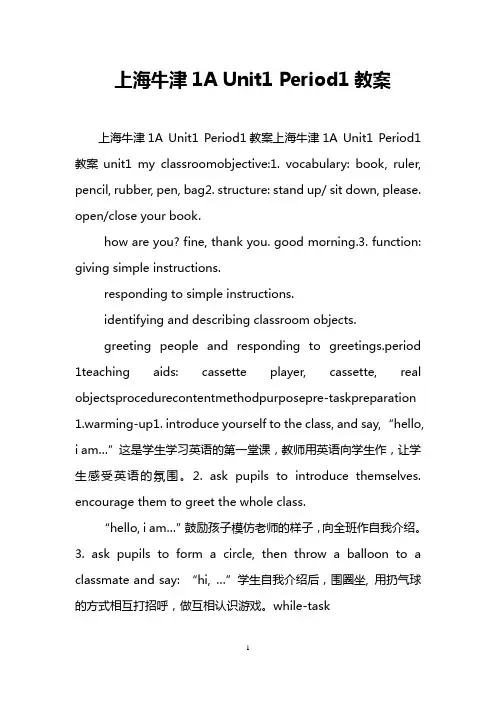
上海牛津1A Unit1 Period1教案上海牛津1A Unit1 Period1教案上海牛津1A Unit1 Period1教案unit1 my classroomobjective:1. vocabulary: book, ruler, pencil, rubber, pen, bag2. structure: stand up/ sit down, please. open/close your book.how are you? fine, thank you. good morning.3. function: giving simple instructions.responding to simple instructions.identifying and describing classroom objects.greeting people and responding to greetings.period 1teaching aids: cassette player, cassette, real objectsprocedurecontentmethodpurposepre-taskpreparation1.warming-up1. introduce yourself to the class, and say, “hello,i am…”这是学生学习英语的第一堂课,教师用英语向学生作,让学生感受英语的氛围。
2. ask pupils to introduce themselves. encourage them to greet the whole class.“hello, i am…”鼓励孩子模仿老师的样子,向全班作自我介绍。
3. ask pupils to form a circle, then throw a balloon to a classmate and say: “hi, …”学生自我介绍后,围圈坐, 用扔气球的方式相互打招呼,做互相认识游戏。
《牛津英语1AUnit1》说课教案
《牛津英语1A Unit 1》讲课教课设计《牛津英语 1A Unit 1》讲课教课设计《牛津英语1A Unit 1》讲课教课设计我讲课的内容是《牛津英语1a 》unit 1my classroom的第八教时,讲课时间 20 分钟。
这是一堂儿歌的教课课,面对的学生是刚入学两周的少儿。
在这两周内,学生初步接触了文具类单词paper, pencil, rubber, pen, bag, book,以及简单的、讲堂用语。
本课时的教课内容为:学会用 for you and me的句型与人分享属于自己的东西。
依据这一安排和学生的整体认识水平,从知识教课、能力培养、感情策略等方面考虑,我确定本课时的教课目的: 1. 能听懂会说 paper, a pencil, for you and me.2.能流利地说出本首儿歌。
3.能用for you and me 的句型进行口语社交,学会与人分享物件的用语,激发学生学习英语的兴趣。
教课要点: 1. 学会用英语表达与人分享的句子 .for you and me.2.培育学生朗诵儿歌时的语感 .(这是小学阶段的第一首儿歌。
)教课难点 :能正确的发音 for you /for me .为实现以上目标 ,我是这样设计教课过程的:howwhy1andi.pre-task preparation:准备阶段安排了两个内容:1.game: roll, roll, let ’s roll. 这是“滚雪球”的游戏 ,作为这堂课的热身、复习运动。
老师先给出一个 model ,让学生将这段内容一传二,二传四,这类形式的演练让学生在最短的时间内,有充分的语言沟通的时机。
整个讲堂立刻融入全员参加的气氛中。
2.daily talk: 在热身以后经过老师发问 what can you see inthe pencil-box/classroom ?让学生用前几课时已学句型i can see 回答,这样在复习单词的同时,用看得见摸得着的熟习的实物来演练,创建了一个与实质环境相联合的情形,学生经过察看运用已学的词汇,表现语言的社交性。
牛津1A教案第一单元第一课时的案头活动
牛津1A教案第一单元第一课时
在牛津1A教材的第一单元第一课时,老师安排了一项案头活动,活动的主题是“自我介绍”。
这项活动旨在让学生在轻松愉快的氛围中,加深彼此之间的了解,促进班级的凝聚力和交流能力、口语表达能力的提高。
这项案头活动是如何开展的呢?老师在黑板上画了一张自我介绍的模板,模板上包括了以下几个部分:
1.姓名
2.年龄
3.出生地
4.兴趣爱好
5.未来的梦想
接下来,老师要求每个学生按照模板的要求,填写自己的自我介绍。
学生们在课堂上认真地思考,动笔填写,经过一番努力,终于完成了自己的自我介绍。
接下来,老师安排学生轮流上台,按照自己的自我介绍进行介绍,以此来让大家更好的了解自己。
在介绍结束后,其他学生还要进行提问,例如,你的爱好为什么是这样的?你未来的梦想是怎样实现的?这些问题不仅可以让学生快速了解对方,还能提高学生的口语表达能力和思维能力。
通过这项案头活动,学生之间的距离缩短了,彼此之间增强了交流的沟通,班级的凝聚力也得到了明显的提高。
同时,学生们也更清晰地了解了自己的兴趣爱好和未来的梦想,为未来的发展找到了更好的借鉴。
这项案头活动虽然简单,但是在教育教学实践中起到了重要的作用,为学生的全面发展提供了更好的平台和条件。
希望今后老师们能够在教育教学中更多地遵循学生的兴趣天性,创造更加丰富、富有激情的教育教学环境,激励学生发掘自己的潜能,无愧于未来社会的需要。
牛津译林版1AUnit1Hello教案有教学反思
牛津译林版1AUnit1Hello教案有教学反思一、教学内容二、教学目标1. 让学生掌握基本的问候语,如“Hello”、“Hi”、“Good morning”等,并能灵活运用。
2. 使学生学会用英语进行自我介绍,如“My name is”、“I'm”等。
3. 培养学生的英语听说能力,激发他们对英语学习的兴趣。
三、教学难点与重点1. 教学难点:正确使用问候语和自我介绍的表达方式。
2. 教学重点:基本的问候语和自我介绍的表达方式。
四、教具与学具准备1. 教具:教材、录音机、磁带、卡片、黑板。
2. 学具:练习本、铅笔、橡皮。
五、教学过程1. 实践情景引入:教师扮演不同角色,模拟日常生活中的问候场景,引导学生模仿并练习。
2. 例题讲解:教师讲解教材中的例题,解释问候语和自我介绍的表达方式。
b. Hi, I'm Wang Fang. And you?(嗨,我是王芳。
你呢?)3. 随堂练习:学生分角色练习问候和自我介绍,教师纠正发音和表达错误。
4. 小组活动:学生分成小组,用所学内容进行问候和自我介绍,互相纠正错误。
六、板书设计1. Unit 1 Hello2. 内容:a. Greetings(问候语): Hello, Hi, Good morning, Good afternoon, Good eveningb. Introducing yourself(自我介绍): My name is, I'm七、作业设计1. 作业题目:请用英语编写一段关于问候和自我介绍的对话。
答案示例:A: Hi, my name is Zhang Lei. I'm 12 years old. And you?B: Hello, I'm Li Na. I'm 13 years old. Nice to meet you!2. 作业要求:内容完整,表达清晰,注意语法和标点。
八、课后反思及拓展延伸1. 教学反思:本节课通过实践情景引入、例题讲解、随堂练习等方式,使学生掌握了基本的问候语和自我介绍的表达方式。
2024年牛津译林版1AUnit1Hello教案有教学反思
2024年牛津译林版1A Unit1 Hello教案有教学反思一、教学内容本节课选自2024年牛津译林版1A Unit1 Hello,涉及章节为12页。
详细内容包括:基本的问候语,如“Hello”、“Hi”、“Good morning”、“Good afternoon”等;介绍自己的名字,如“My name is…”;询问他人名字,如“What's your name?”;以及简单的回答,如“Yes”、“No”。
二、教学目标1. 学生能够听懂并熟练运用基本的问候语进行日常交流。
2. 学生能够介绍自己并询问他人的名字。
3. 学生能够在实际场景中运用所学英语进行简单对话。
三、教学难点与重点教学难点:问候语和介绍自己名字的发音及运用。
教学重点:基本的问候语、介绍自己名字和询问他人名字的表达。
四、教具与学具准备教师准备:教学课件、卡片、录音机、磁带。
学生准备:课本、练习本、彩色笔。
五、教学过程1. 实践情景引入(5分钟)教师模拟真实场景,如在校园、家庭、商店等场合,展示如何使用基本的问候语进行交流。
学生跟随教师模仿并进行角色扮演。
2. 例题讲解(15分钟)教师通过课件展示本节课的例题,如对话:“A: Hello, what's your name? B: My name is Tom. A: Hi, Tom. B: Hi.”教师对例题进行讲解,引导学生关注问候语和介绍名字的表达。
3. 随堂练习(10分钟)教师给出练习题目,要求学生根据所学内容完成对话。
学生两人一组,进行对话练习。
4. 互动环节(10分钟)教师组织学生进行互动游戏,如“找朋友”、“快速问答”等,巩固所学内容。
学生反馈学习情况,提出疑问。
六、板书设计1. Unit1 Hello2. 主要内容:Greetings: Hello, Hi, Good morning, Good afternoonIntroduce oneself: My name isAsk for someone's name: What's your name?七、作业设计1. 作业题目:Write a dialogue between two people meeting each other for the first time.Translate the following sentences into English:B. 你叫什么名字?C. 早上好!Fill in the blanks with the correct form of the words given.2. 答案:A: Hello, my name is Li Hua.B: What's your name?A: My name is Li Hua.B: Good morning!A. Hello, my name is Li Hua.B. What's your name?C. Good morning!八、课后反思及拓展延伸1. 教师反思:本节课通过实践情景引入、例题讲解、随堂练习等环节,让学生掌握了基本的问候语和介绍自己名字的表达。
- 1、下载文档前请自行甄别文档内容的完整性,平台不提供额外的编辑、内容补充、找答案等附加服务。
- 2、"仅部分预览"的文档,不可在线预览部分如存在完整性等问题,可反馈申请退款(可完整预览的文档不适用该条件!)。
- 3、如文档侵犯您的权益,请联系客服反馈,我们会尽快为您处理(人工客服工作时间:9:00-18:30)。
课题Unit 1 Hello
(1A)
课型
新授
课时
2
主备人
汤雪莲
教学日期
教
学
要
求
1. Using imperatives to give simple instructions.
2 .Using formulaic expressions to greet people.
3. Using nouns to identify common classroom objects.
Show the picture “Open your book”. Ask the class to do the action.
?A competition between boys and girls. T: Close your book. T: Boys, stand up, please. Girls, open your books.
Post-task activity
1.? ? ? ? Let group of 4 to practice and show themselves in front of the class.
2.? ? ? ? Play a game: Class is over. (Practice)
Homework
?
Let Ss listen to tape.
教
学
活
动
内
容
教学活内容与主要问题的设置
执教人修改内容
师生活动要点
the picture “Close your book”, and let Ss practice.
one capable student do the action and elicit “Open your book”. Let students read it.
4. Using model verb “can” to express abilities.
5. Lean an English song.
教
学
重
难
点
1. Using imperatives to give simple instructions.
2 .Using formulaic expressions to greet people.
3. Using nouns to identify common classroom objects.
教
具
学
具
Multimedia,
cassette
教
学
活
动
内
容
教学活动内容与主要问题的设置
执教人修改内容
师生活动要点
1.?Show the picture with a boy sitting on the chair, and elicit “Sit down”. Let Ss response to the order. Let students read it one by one. Correct the pronunciation.
2.?Use the same method to teach “Stand up”. Look, the boy is standing up.
3.?To elicit “Stand up, please.” Let students read it one by one. Correct the pronunciation.
Practice “Open…”let all the students shout, xxx, open the door! Then the student who is named xxx should open the door. Teacher can change “door” into “window, book…”
response. Teacher gives order and Ss do the action together.
5. Read a rhyme.
Say “Close your book”. Do the relevant action, and let Ss understand. Let students read it.
Speak and act.
Say a rhyme: o, o, open your book, c, c, close your book.
